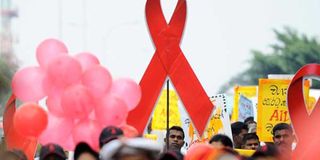HIV's origins traced to Kinshasa in 1920s

A gathering to mark World AIDS Day at a prison complex in Colombo on December 1, 2013. A new genetic history of HIV shows how the pandemic almost certainly took root in the 1920s in Kinshasa in the DRC. PHOTO | FILE
What you need to know:
- An international team of researchers reconstructed the genetic history of the HIV-1 group M pandemic, and found that the common ancestor of group M is "highly likely" to have emerged in Kinshasa around 1920.
- Then, looking at genetic data, scientists could see that HIV spread across what is now the Democratic Republic of the Congo (formerly the Belgian Congo and Zaire) to other major cities, by the early 1950s.
- Campaigns to treat people with sexually transmitted diseases may have been carried out using needles that were not sterile, suggesting another route for HIV and co-infections with hepatitis C that are often seen in men in the DRC over 50.
WASHINGTON
A new genetic history of HIV shows how the pandemic almost certainly took root in the 1920s in Kinshasa in the Democratic Republic of Congo, researchers said Thursday.
Assisted by train transport and the sex trade, the virus that causes AIDS then spread across the continent and eventually the world, infecting some 75 million people and killing 36 million of them.
An international team of researchers reconstructed the genetic history of the HIV-1 group M pandemic, and found that the common ancestor of group M is "highly likely" to have emerged in Kinshasa around 1920.
While various strains of human immunodeficiency virus (HIV) have jumped from primates and apes to humans at least 13 times, only one such transmission event has led to a human pandemic.
PERFECT STORM
And it did because it was aided by "a 'perfect storm' of factors, including urban growth, strong railway links during Belgian colonial rule, and changes to the sex trade, combined to see HIV emerge from Kinshasa and spread across the globe" between the 1920s and 1950s, said the study in the journal Science.
"For the first time we have analysed all the available evidence using the latest phylogeographic techniques, which enable us to statistically estimate where a virus comes from," said senior author Oliver Pybus of Oxford University's Department of Zoology.
"This means we can say with a high degree of certainty where and when the HIV pandemic originated."
A key factor in the pandemic's spread was the use of trains as transport, which helped bring the virus from isolated pockets of people into the larger city, which was Kinshasa, among the best connected of all central African cities.
"Data from colonial archives tells us that by the end of 1940s over one million people were travelling through Kinshasa on the railways each year," said Nuno Faria of Oxford University's Department of Zoology, first author of the paper.
Then, looking at genetic data, scientists could see that HIV spread across what is now the Democratic Republic of the Congo (formerly the Belgian Congo and Zaire) to other major cities, by the early 1950s.
These regional hubs were connected to southern and eastern African countries.
"We think it is likely that the social changes around independence in 1960 saw the virus 'break out' from small groups of infected people to infect the wider population and eventually the world," Faria said.
MULTIPLE ROUTES
These social changes include sex workers who took on a large number of clients, coupled with "public health initiatives against other diseases that led to the unsafe use of needles (which) may have contributed to turning HIV into a full-blown epidemic," the study said.
Campaigns to treat people with sexually transmitted diseases may have been carried out using needles that were not sterile, suggesting another route for HIV and co-infections with hepatitis C that are often seen in men in the DRC over 50.
HIV was first identified in 1981, and the AIDS epidemic ballooned for more than a decade until antiretroviral drugs were created. These long-term regimens have transformed HIV from a fatal disease into a chronic condition for many of those infected.
Researchers said further study is needed to understand the different social factors that enabled the virus to spread the way it did.




